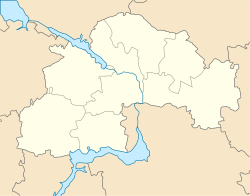Zhovti Vody
Жовті Води | |
|---|---|
 Zhovti Vody Palace of Culture | |
| Coordinates: 48°21′0″N 33°30′0″E / 48.35000°N 33.50000°E | |
| Country | |
| Oblast | Dnipropetrovsk Oblast |
| Raion | Kamianske Raion |
| Metropolitan area | Kryvyi Rih metropolitan area |
| Hromada | Zhovti Vody urban hromada |
| Founded | 1895 |
| City | 1957 |
| Area | |
• Total | 33.25 km2 (12.84 sq mi) |
| Population (2022) | |
• Total | 42,052 |
| • Density | 1,588/km2 (4,110/sq mi) |
| Postal code | 52290- |
| Area code | +380-5652 |
| Website | zhv |
 | |
Zhovti Vody (Ukrainian: Жовті Води, IPA: [ˈʒɔu̯tʲi ˈwɔdɪ]; lit. 'yellow waters') is a city in Kamianske Raion, Dnipropetrovsk Oblast, central Ukraine. It is located on the Zhovta River approximately 70 km (43 mi) north of the metropolitan area's center, Kryvyi Rih. It hosts the administration of Zhovti Vody urban hromada, one of the hromadas of Ukraine.[1] Population: 42,052 (2022 estimate).[2]
Since 1951[3] and hence forward during the soviet era, the city became a "secret city" (possibly a closed city) codenamed "Mailbox 28",[4] and did not feature on maps,[5] because of the establishment in the city in 1951 of a uranium mine and mill for the extraction and processing of uranium ore - although mining of uranium locally in the city has since officially ceased.
Present day activities of the "Eastern Mining and Processing Enterprise" - VostGOK - headquartered in the city are reportedly concerned with extraction of iron ore and production of hydrochloric acid[6] as well as the continued milling of uranium ore mined from more distant regions further to the east, and as such VostGOK is the largest European and the only Ukrainian extractor of uranium ore and only Ukrainian producer of uranium concentrate.[7]
Considerable parts of the city and its surrounding farmland are severely and dangerously polluted with uranium ore (and consequently radon gas in buildings built on uranium ore found naturally in the granite of the city, or due to the use of uranium containing granite in building foundations),[8] with radioactivity levels in some instances in the city comparable to heavily contaminated areas surrounding Chernobyl,[9] with residents suffering increased incidence of congenital conditions and cancers, many of which have been conclusively linked to radiation exposure.[10][11] There appears to be evidence of disposal of uranium contaminated machinery at the edge of farmland surrounding the city, which contaminates nearby crops, and when excavated by scrap metal foragers, contaminate the individuals who handle the uranium contaminated scrap-metal, as well as those who come into contact with the individuals contaminated (family members, neighbours, etc).
- ^ "Желтоводская городская громада" (in Russian). Портал об'єднаних громад України.
- ^ Чисельність наявного населення України на 1 січня 2022 [Number of Present Population of Ukraine, as of January 1, 2022] (PDF) (in Ukrainian and English). Kyiv: State Statistics Service of Ukraine. Archived (PDF) from the original on 4 July 2022.
- ^ "Nuclear Power in Ukraine | Ukrainian Nuclear Energy - World Nuclear Association". www.world-nuclear.org. Retrieved 2024-04-19.
- ^ Zhang, Izabela Radwanska. "In a small town where radiation permeates the ground, life continues on - 1854 Photography". www.1854.photography. Retrieved 2024-04-19.
- ^ Radioactive City: The Second Chernobyl | Documentary. Retrieved 2024-04-19 – via www.youtube.com.
- ^ Radioactive City: The Second Chernobyl | Documentary. Retrieved 2024-04-19 – via www.youtube.com.
- ^ admin (2023-11-08). "Ukraine: VostGOK managers accused of embezzlement". The Ukrainian Metal. Retrieved 2024-04-19.
- ^ Radioactive City: The Second Chernobyl | Documentary. Retrieved 2024-04-19 – via www.youtube.com.
- ^ Radioactive City: The Second Chernobyl | Documentary. Retrieved 2024-04-19 – via www.youtube.com.
- ^ "Dark Element | The Walrus". 2010-04-12. Retrieved 2024-04-19.
- ^ Radioactive City: The Second Chernobyl | Documentary. Retrieved 2024-04-19 – via www.youtube.com.



